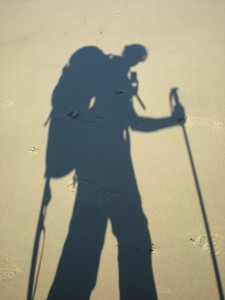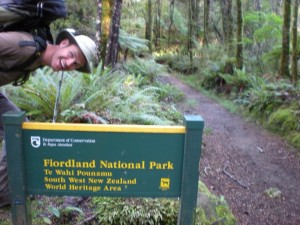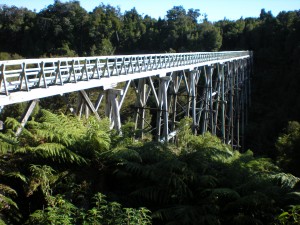Not that I haven’t met many truly wonderful Kiwi’s, but I have to say my experiences at large have been disappointing. While anecdotal, a Kiwi restaurant patron where I used to work raved to me about how wonderful her time in America had been and how struck she was by American friendliness. No offense to our amazing wwoofing hosts and awesome kiwi friends, but when it comes to interacting with strangers, I’ll take the U.S. over Kiwi-land any day.
And so it was that we arrived in Tuatapere (Too-uh-tap-er-ee), a bit jolted by a complete absence of polite geniality from the woman at the Invers I-Site to the proprietor of the internet shop to the Hump Ridge booking office. Friends and colleagues had put us on to a well-known hiking trail in this area, but we failed to catch wind of the fact that it’s not managed by the NZ forest service (DOC). As such, there is absolutely no way to hike the loop without paying $130 each. That’s not a typo. And of course the blow was strengthened by the I-Site worker bullying us toward a “booking” on the trail — an unfortunate hallmark of New Zealand’s weird commission-based tourism booking industry. To add insult to injury, the doors to the home of the famous Tuatapere sausage had been boarded up a week prior to our arrival, and the town’s streets were all but deserted.
After re-grouping and a night of rest, we tackled the South Coast track — the public trail that connects the elite Hump Ridge track to the outside world. We raced the sun along a beautiful coastline — sometimes on gorgeous secluded beaches with stunning backdrops, and sometimes in the mossy New Zealand forest. Constant aggressive signage about the Hump Ridge track – warning walkers not to even think about going near it without paying – showed up frequently along the trail. The wording would make the unknowing hiker assume he or she was already on the precious track and practically committing a felony with every step. Not winning a lot of tourism dollars here, Tuatapere!
Our sunset arrival at the “hut” – the old school house from a logging town of days past — was idyllic. The schoolhouse itself — Victorian architecture painted white with apple-red trim was too adorable. Inside we discovered three tiers of bunk platforms that made me feel like I was back in grade school
exploring the world. An ominous conversation with hikers we’d met on the trail sort of prepared us for the only disappointment of the trip — Jenny and Theresa, a mother-daughter duo from a farm on the North Island (Hamilton). No matter how often or humbly we tried to make conversation, they luxuriated in snobbery like pigs in muck. “So… what’s your favorite trail meal?” “Oh… when you’re out in the real rough and tough back-country for days on end like we are, it all just tastes the same.” “Hmmm… so was the track coming down off Hump Ridge (they had paid to do the hike) muddy?” “Nope. It was great.” “Oh, It says here in this pamphlet that it usually is muddy (and our entire hike in had been full of mud).” “Well, you have to
understand. We’re *farmers.* If it’s only ankle deep, it’s *hardly* mud.” And finally , when asked about their trip plans (aka when are you LEAVING?!) the mother’s nonchalant story about losing two toe-nails on the hike down off the ridge and “not realizing it.” She “just thought a piece of bark was caught” on her sock. Ew!
We escaped the pair for the day and hiked a few hours up to “the oldest, largest wooden viaduct in the Southern hemisphere” – part of the elaborate and remote logging operation that ran for a decade in this farthest south, farthest west corner of New Zealand. When we returned to the schoolhouse, we searched around for one of the village-remains-walking-tour-pamphlets promised by signage. There were none about. I quizzed our hut companions
who gave me blank stares. I explained slowly and clearly before daughter made eye contact with mother and reluctantly dug one out of her pocket. “You can use mine. But I want it back.” Sheesh! It was neat to see all the lingering components of the former town, and the literature managed to paint a picture that few historical sites usually do. The beach and former port were gorgeous and we even got to see Hector’s dolphins! The ladies vacated early the next day, leaving us with a peaceful morning and return trip to the parking lot.
More photos of this gorgeous place by clicking here.










Twitter Facebook Google+ StumbleUpon Reddit Pinterest